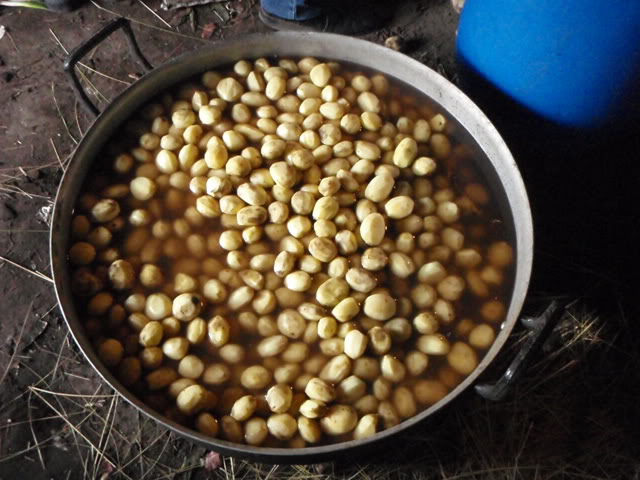
Groundnut breeding II
Lead Organization:
International Crops Research Institute for the Semi-Arid Tropics (ICRISAT)
Partner Organizations:
Ekwendeni Hospital, Kamuzu Central Hospital, Masasi High Quality Farmers Association, ARI Naliendeli
Community of Practice:
Countries:
Malawi and Tanzania
Duration:
3/2010—3/2014
Overview:
In Malawi and Tanzania groundnut is grown on 316,000 ha by more than 300,000 households providing a highly nutritious (12-36% protein, 36-54% oil) component for otherwise cereal-based diets. From 2006 to August 2010 CCRP funded a Groundnut Breeding project for southern Africa led by ICRISAT to strengthen existing work on foliar disease resistance breeding in Malawi, build capacity in the Tanzania NARS to select resistant lines, engage farming communities in the breeding and selection process and pilot local groundnut seed initiatives through the NASFAM farmers association in Malawi and by working with NGOs in Tanzania. Breeding and selection work has provided lines with resistance to groundnut rosette virus disease (GRD), early leaf spot and groundnut rust, selected other early maturing and high yielding farmer preferred lines proposed to national authorities for release in Tanzania and has demonstrated workable local seed systems with farming communities and other stakeholders. A second four years period of funding for this research partnership takes forward breeding and selection work to release and promote GRD resistant cultivars in Tanzania and by the end of the project provide cultivars that combine resistance to all three major foliar diseases that constrain groundnut productivity in region. Research funded by CCRP in Malawi in 2009 has revealed that the proven carcinogen aflatoxin is a widespread contaminant of groundnuts and groundnut based foods consumed in the country. While groundnut grains destined for export are subjected to rigorous testing there is no monitoring of nuts produced for the local market or consumed by producers. Furthermore there is limited awareness of the problem among producers, traders, consumers or policy makers. Aflatoxin contaminates groundnut as a result of a soil borne fungal infection. The project is now diagnosing the extent of the problem in Tanzania and in partnership with medical researchers in Malawi investigating consumer exposure and associations with infant malnutrition and medical disorders including hepatitis. On-farm trials and demonstrations will be undertaken with extension and NGOs to evaluate the potential of reducing aflatoxin contamination via improved pre- and post-harvest practices. On the basis of evidence generated, the project team will raise awareness among producers, traders and consumers through field days, agricultural shows, seed fairs and the media. The lead will also be taken to advocate appropriate policy to national governments establish to agree standards, establish education programs and routine testing of groundnuts in local food chains. Project funds also support overseas training of an MSc. student in plant pathology and provide research project opportunities for undergraduate and post-graduate students in Tanzania.
Grant Aims:
High yielding farmer and market-acceptable groundnut varieties with resistance to foliar/viral diseases and aflatoxin contamination developed;Nutritional status, dietary diversity, human health and mycotoxin contamination problem spatially characterized;Adoption rates of improved farmer and market-acceptable varieties and production technologies enhanced;Capacity of partners for management of mycotoxins in food, variety development and enabling policy environment enhanced
Outputs and Outcomes:
- Building on phase 1 a number of germplasm lines with good resistance to groundnut rosette disease, rust and aflatoxin have been identified and formed a basis for further hybridization activities in Phase II.
- A system for growing groundnuts in fungus contaminated soil in large containers has been established at Chitedze Research Station to allow lines to be screened for aflatoxin resistance under drought stress.
- In collaboration with Ministry of Health, the project sampled aflatoxin levels in blood of inhabitants of two districts with high levels of aflatoxin to establish levels of human potential of aflatoxin for human contamination.
- A survey of aflatoxin prevalence in groundnuts was also completed in major producing regions of Tanzania. Farmers preferred groundnut lines have been identified where in Malawi most farmers preferred ICGV-SMs 99722 and 99551 while in Tanzania the farmer preferred varieties were ICGV-SMs 01731, 02724 and 02715.
- Two (2) field days were conducted in Malawi engaging 797 stakeholders in order to increase an understanding on issues of aflatoxin and groundnut.
- One field day was conducted in Tanzania engaging 100 stakeholders in order to increase understanding of aflatoxin and groundnut.